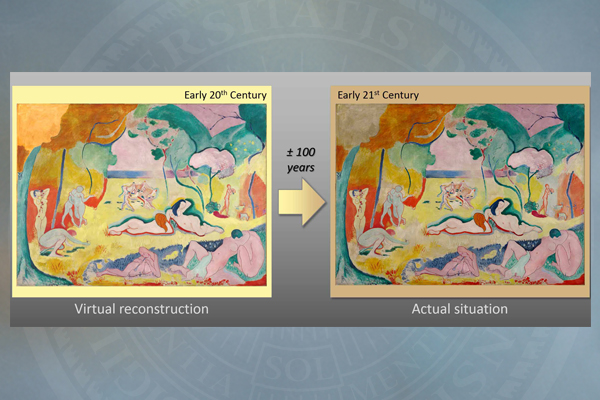
Fade to beige
Researchers find reasons Matisse's bright yellow pigments discolor
3:29 p.m., July 6, 2015--An international team of scientists led by Jennifer Mass, Winterthur Museum's senior scientist and an affiliated University of Delaware faculty member, has announced new findings on why a bright yellow pigment favored a century ago by master artists like Henri Matisse fades to drab beige.
The study, published in the June 2015 issue of Applied Physics A, calls for the development of international protocols to identify and help preserve "at risk" paintings.
Research Stories
Chronic wounds
Prof. Heck's legacy
The research team found that the original chemical compound, cadmium sulphide, which is highly water-insoluble and bright yellow, is subject to a light-induced oxidation process that transforms it into a colorless, water-soluble cadmium sulphate. The cadmium yellow favored by Impressionist, post-Impressionist and early modernist masters poses a risk to many masterpieces of our cultural heritage, the study notes.
“The results of this study reveal how critical it is to understand not only the chemistry of the discolored paint, but also the chemistry used to prepare the paints that were available to the turn of the 20th century’s most enduring artists,” said Mass, a chemist who is senior scientist at Winterthur's Scientific Research and Analysis Laboratory and an affiliated associate professor in the Winterthur/University of Delaware Program in Art Conservation.
"Our study points the way toward several important areas requiring further investigation, among the most critical of which is developing a protocol for identifying the 'at risk' paintings that are in their earliest stages of degradation, even before it is visible to the naked eye, so that such works can be placed in the proper display environments that will prevent their degradation from worsening."
The team employed a combination of sensitive, state-of-the-art methods of investigation based on synchrotron radiation at the European Synchrotron Radiation Facility (ESRF). These included X-ray diffraction, X-ray absorption spectroscopy, X-ray fluorescence analysis and infrared microscopy.
Although the study focused on pigments from Matisse's "The Joy of Life" at the Barnes Foundation in Philadelphia, it also presented contributing evidence from earlier investigations with the ESRF on works by masters such as James Ensor and Vincent Van Gogh, in addition to Matisse.
“As a chemist, I find it striking that in paintings of different artists and different geographical origins that (presumably) were conserved for circa 100 years in various museum conditions, very similar chemical transformations are taking place,” said Koen Janssens, chemistry professor at the University of Antwerp in Belgium. “This will allow us to predict with higher confidence what may be happening to these works of art in the coming decades.”
The ESRF noted there has been a growing realization among museum scientists over the past decade that this disfiguring phenomenon is affecting billions of dollars of our global cultural heritage. Mass said the findings aid in understanding how to digitally restore damaged paintings and create a computer-generated image that reveals the artists’ original intent.
“When we combine our findings on the works of Henri Matisse with the studies carried out on works by Vincent Van Gogh and James Ensor, the understanding of their degradation gives us a road map to guide us in the preservation of these works,” Mass said.
“It also provides us with the information needed to digitally restore the damaged paintings, creating a computer-generated image that reveals the artists’ original intent.”
Image courtesy of Winterthur Museum








